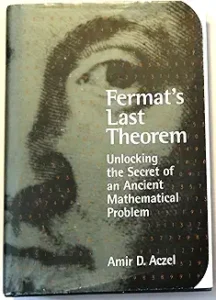Fermat’s Last Theorem: Unlocking the Secret of an Ancient Mathematical Problem by Amir Aczel 1996
Some of you who read last month’s update might recall a book by the Nobel Prize winning Wislawa Szymborska, “Nonrequired Reading” in which she reviewed 97 books of which only one appealed to me. This was the book.
I was interested in reading it because Andy, a close friend who went on to earn a PhD in math at Berkeley, used to talk to me over lunch in college about ‘rings over fields’ and other esoteric math concepts that failed to pierce my veil of ignorance. I had taken calculus in college for my pre-med requirement, but it also failed to make any impression on me. So, having heard of Fermat’s Last Theorem, I figured, why not give this book a try.
Guess what. I read all 139 pages of this book, and while I did recognize some of the shorter words, like ‘the’, ‘and’, and ‘Plato’, that was about the sum of my understanding. Names of famous mathematicians from Archimedes and other ancient Greeks through the Muslims in the 7th C CE, from Euclid to Gauss, from Fibonacci to Galois streamed past my dazed eyes while esoteric fields of math from number theory to topology, from the Tamiyara-Shimura conjecture to semistable elliptic curves left me in the dust. It was back to Winthrop House lunch all over again.
I did come away from this book with several useful observations. First, the development of math like medicine and other scientific areas is an accretive process. Generation after generation master their teachers’ concepts and work and then leap beyond them, building an edifice that relies on fact, proof, and reproducible results. Second, the conflicts and feuds in academia are omnipresent whether we’re talking political science or math, and reflect the truth of an old saw that conflicts in academia are so violent because the stakes are so small. Third, the commitment, yea obsession of one person is sometimes necessary to make a critical leap in understanding. In this case, the Princeton mathematician, Andrew Wiles worked on the proof of Fermat’s Last Theorem for seven years in isolation and secrecy only to have his proof fail when he went public. Wiles went back to his attic office and a year later emerged with a proof that has stood the test of time since 1993.
For those of you tempeted to read this book, here’s a sample of the writing: “Extensions of the periodic functions of Fourier to the complex plane, linking together these two areas of mathematics, would lead to the discovery of automorphic functions and modular forms–which also had a crucial impact on Fermat’s Last Theorem through the early twentieth century work of another French mathematician, Henri Poincare.” Take that Andy!
The bottom line for me is that a French jurist in the mid-17th C wrote down an equation in the margin of an arithmetic book written in Latin by Diophantus in the 3rd C, and for the last 400 years, people have been trying to prove his theorem. Having done so did not bring world peace, abolish hunger, or win a gold medal at the Olympics, but it did satisfy a drive to know, in this case to prove that for no number higher than 2 does the equation x to the n power plus y to the n power equal z to the new power. If this whets your appetite, read Aczel’s book. If it made you yawn, move on to another choice.



